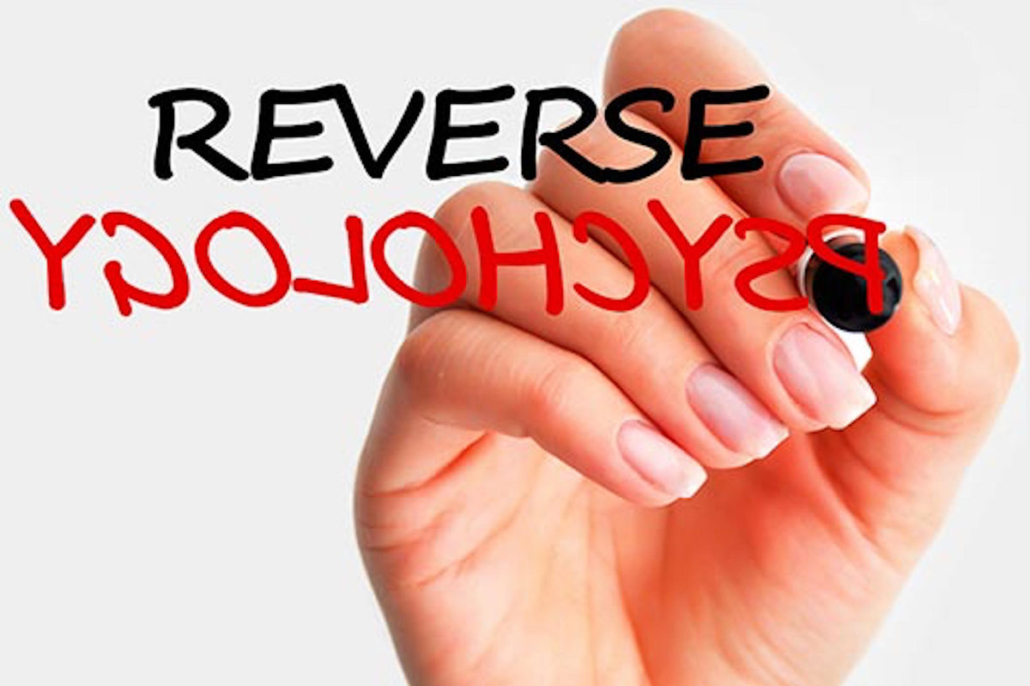Guide to negative reverse selling(Sandler Selling System); Prospective clients basically swing around between two extreme positions during the buying process. Sometimes they may be very optimistic and ready to buy.
While sometimes, they may be very negative and they even do not need our company, our product or our service. For a selling perspective, it is not advisable to pursue directly the prospect to purchase the product or service.
The salesperson can better control and direct the selling process by acting in a manner contrary to what the prospect has come to expect from salespeople. That is called reverse negative selling. In a nutshell, it is the art of making others sell among themselves.
What is negative reverse selling?
“Negative reverse selling” is a sales technique called “Reverse Psychology” which helps in leading conversation to test the commitment of prospective clients. It is achieved by posing questions and making comments that run counter to the purpose of a sale for a closer. 
Reverse Psychology
As per the Cambridge Dictionary, “Reverse Psychology is a method of trying to make someone do what you want by asking them to do the opposite and expecting them to disagree with you”. In a simple way, it can be explained as under:
- Do something that will usually have the opposite outcome of what you want.
- Tell others to do the opposite of what you want them to do.
The very objective of negative reverse selling is to give the opportunity to the prospective clients for reconsidering their decision or explaining the reasons behind their objections.
How to use negative reverse selling?
Negative reverse selling fits into the system when a prospect starts asking questions, expressing concerns, or “thinking about it”. The negative reverse for every deal is not a concrete step in the entire process but may be used as a strategy to use when the situation is hard to overcome.
Negative reverse selling pushes the prospect of clients and tests their reaction to an idea rather than jumping to close the sale at the first opportunity. David H. Sandler (creator of this strategy) compares it to fishing and many propose a ‘stripping line’ strategy too.
When we go for fishing and feel a bite of fish, we should not immediately set the hook (as we may lose the fish here at the first bite). Instead, we should give the fish some line to run, let them take the bait, and catch themselves.
The same stands for sales. If the prospect shows interest and we are ‘setting the hook’ (go for the close instantly) too early, chances are there the client may suspicious and change his/her mood. Instead, do the opposite of what we want, and give the clients some space to sell themselves!
What is reverse psychology example?
Patagonia published an audacious full-page advertisement in The New York Times (2011 Black Friday edition), which asked viewers not to buy their jacket.
Just below the picture of the jacket, there was a message that explained why customers should not purchase the product.
Among the factors mentioned (not to buy the product!!) are the 36 gallons of water needed to manufacture the jacket (sufficient to fill 45 people’s daily needs), the 20 pounds of carbon dioxide released (24 times the weight of the jacket), and the amount of waste created (two-thirds of its weight in waste).
In doing so, after the campaign, sales rose 30 percent. It not only boosted the selling but also created awareness of the highly pressing problem of the time.
Does negative reverse selling actually work?
Yes, it works perfectly but not everywhere. It is a powerful technique used by many successful salespersons. But a high level of experience and practice is required for this.
It needs salespersons to withhold enthusiasm at first, stop thinking about their own product, service, and business, and more specifically not to provide solutions to what we consider to be the problems of the prospective clients.
By making statements and asking questions exactly opposite of what the client expects, we can get the prospect moving in the direction you want them to go.
For instance, a conventional salesperson may make a statement, “I hope, you would like to increase your sales and income”. To this type of direct question, the standard answer of the prospect may be, “Thank you, our sales and revenue are perfectly fine to our plan.”
This closes everything. The proper way to ask the same question using the reverse selling technique would be “Are you not interested in improving your sales and income?” There are not many differences in the statements raised in both cases. But in the second case, there is ample scope for the prospect to “pull back”.
The obvious response may be – “Of course, I am interested in improving sales and income. But, how would your service helpful to me? Can you please explain?”
How to deal ‘NO’ using negative reverse selling?
“No” comes in many essences – the right-away ‘No’, the ignoring you ‘No’, I am too busy, ‘No’ etc. For selling prospects, these nos’ hurt and sometimes with good reason too. Even, sometimes clients are disrespectful to their own statement.
When the prospective customer seems to be interested in the novice, the over-eager salesperson whips the contract out. Here, the prospect smells of a rat at that moment and is likely to run away by means of examining their “no”.
It is where the strategy of “negative reverse” works. To bring the prospect forward, it is all about taking one step backward. Here, what you need to do is to challenge the prospect to be good to themselves.
Let us take an example: Suppose after a detailed deliberation, the prospect says ‘no’ to our proposal for a training proposal to his team. Here, the direct closer statement may be, “Well it sounds to us like you are not interested in moving forward on training your team ….”.
This direct and polite statement may not be as thoughtful as the client should be. But, if we could give a statement like, “We are sorry that our proposal does not suit your requirement. However, we are sure that after reviewing other proposals, you would give enough thought to our services?”
Reverse Selling Psychology – By David H. Sandler
David H. Sandler coined the term, “negative reverse selling” as a part of the “Sandler Selling System” in 1967. The system’s aim is to persuade the prospect that they are following the offer and wanting the product, rather than ‘selling’ them through the traditional selling system such as through the sales representatives.
For the traditional selling system, credit goes to St. Elmo Lewis, who was ironically imprisoned for violating antitrust laws.
In our daily lives, we witness this approach in thousands of times, namely door-to-door salespeople, retail stores, multi-level marketing pitch sessions, and networking events, etc. The question now is who is winning in this traditional buyer-seller dance? Nobody wins.
Many people believe salesmen are deceptive, but it is fair to say the prospect may be just as deceptive as the salesman. The salesperson is giving up their unpaid advice and the amateur buyer is left to make a partly informed decision.
Most people do not even know about it but have adapted a strategy of self-defense against the typical salesperson. These complementary systems wrecked confidence.
But, the thumb rule in Sandler Selling System is, “Stop playing the games buyers play”. Here. we need to change the way we approach sales and just do the wrong thing more enthusiastically.
The traditional sales training teaches us how to get better at playing the sales game while the Sandler Selling System emphasis on three key stages designed to ‘prevent the games from ever being played’:
- Building and sustaining the relationship – In buyer/seller dance, you will learn how to take the lead, set clear goals, and set guidelines for the ultimate decision, all while creating an open, honest partnership.
- Qualifying the opportunity – You may discover how you, the salesperson, can decide whether the expectations, budget, and decision-making process of the prospect match well.
- Closing the Sale – If the prospect applies for your approach, then you’ll learn how to make a no-pressure presentation, confirm the agreement, and set delivery and referral requirements.
Negative Reverse Selling Sales Meeting Plan
The rationale behind this meeting plan is to give training to your salesperson on Sandler’s well defined “Negative Reverse Selling”. For this purpose “Questioning Techniques’ may be applied. The aim of this meeting plan is to understand how the selling process can be controlled by acting in a way that is contrary to what the prospect expects.
Additional materials may be checked prior to holding this meeting, including ‘Sandler Negative Reverse Selling’ and recommendations available about what to include in the training class, and accordingly, a presentation may be planned.
Participants may be advised to complete some pre-work assignments in preparation for this session. E-Learning courses on ‘Sandler Negative Reverse Selling’ along with other resources can be shared as under with them in advance.
- Overview of the topic with activities, case studies, talking points, and discussion questions
- Handouts to use during the meeting (if any)
The trainer should ensure that all participants, as a takeaway of the meeting, have experienced a role-playing negative reverse selling tactics with their respective sales manager.
Negative Reverse Selling Ideas for increasing Sales
In difficult sales conditions, you may use negative reverse selling. When the prospective customer:
- Expresses to break a deal
- Thinks other options (from competitors)
- Objects to price, timeline, or delivery
- Drags his feet
Negative Reverse Selling
Negative reverse selling should not be used as a primary sales tactic but as a means of breaking a stalemate. It is a challenge that tests the interest of leader and cuts through the formality.
Negative reverse selling is like a pendulum. It swings back in the opposite direction if we pull in one direction and let it go. Do not move it in the right direction, drag it in the opposite direction.
Their propensity to ‘pull off’ sales representatives will drive them in the direction we want them to go. There is no such fixed ideas to increase our sale rather it varies case to case.
For instance, the example of “not to buy their jacket” by Patagonia and why not to buy with reasons. All the reasons are the awareness of the highly pressing social problems like ‘water scarcity’, ‘save the environment’ etc.
Let us take another example of where we can use the “negative reverse” technique in our day to day activity like, to feed our kids at the dinner table.
If the “food” looks good, smells good and obviously tastes good, then our problem is almost solved but sometimes kids behave differently as if they are not hungry (which is the role of salesperson for prospective customers like a hungry child)!! Here, we do not have to do much and just to present the food and then back. Let the testy food sell itself.
We just need to give our prospect some space like this. Allow him to develop self-interest and to come to the right decision. Some examples of the “negative reverse” dinner table technique, just to give our children an interest in this:
- “Are you sure you are hungry?”
- “Would you like any?” (Instead of it)
- “I’m not sure I made enough for everybody to have some.”
- “It’s kind of an adult taste.”
- “Good. Leaves more for the rest of us.”
Negative-reverse sale strategy is a time-tested, reliable, and validated way of harnessing negative energy from prospects.
Especially when we have dialogs in progress and the client drags his feet at the closing part of the deal it can be used for the benefit of both sides. We need to confirm it a bit more here for the win-win scenario to be accomplished.


